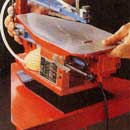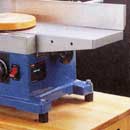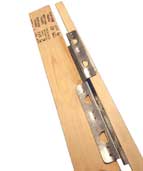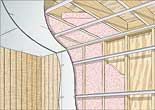|
your home. Even if your shop is detached
from the house, chances are that it sits within earshot of neighbors
who have little desire to listen to noisy woodworking tools. Luckily,
you can keep the sound under control by working to reduce tool noise
and by "soundproofing" your shop space to prevent noise
from escaping.
Reducing Tool Noise:
•Keep Bits and Blades Sharp:
Dull, dirty cutting tools don't just produce poor results. They
make more noise. Keep them sharp to cut down on noise.
•Tune Up Your Tools: Tools that are out of adjustment
run louder than those that are in tune. Make sure yours are properly
set up to get quieter—and better-quality—cuts.
•Keep Tool Stands Tight. Metal tool stands vibrate
and make a lot of noise if all of the bolts that hold them together
aren't tight. Snug down all those bolts well when you assemble stands,
and check them periodically to make sure none have vibrated loose.
 |
 |
| Anti-Vibration
Pad |
Isolation
Mounts |
•Control Bad Vibrations.
Instead of mounting a tool directly to its metal stand, use anti-vibration
pads or rubber feet (both shown above) to keep vibrations from transferring
into the stand and creating more noise. You can also put rubber
pads under the feet of the stand itself.
•Build Beefy Bases. If you
just can't quiet down a metal stand, consider replacing it with
a shop-built version made from a dense material, such as medium-density
fiberboard (mdf).
Reducing Shop Noise
The strategies above help reduce tool noise, but you'll probably
still find that sounds escape the confines of your shop. That's
because when sound waves strike a surface, such as a wall, they
cause the surface to vibrate. This effectively turns the surface
into a big loudspeaker that "rebroadcasts" the sound into
the surrounding area. You can't completely "soundproof"
your shop, but you can dramatically reduce the amount of noise that
escapes by using one or more of three methods: insulation, isolation,
and adding mass.
•Insulate Wall Cavities. The
easiest way to help prevent noise from traveling through a wall
or ceiling is by adding insulation. It helps absorb some of the
vibrations. While any insulation helps, several companies offer
varieties specifically designed for sound-deadening. Whichever type
you use, install it according to instructions because over-stuffing
the wall may drastically reduce performance.
•Isolate the Wall and Ceiling Surfaces.
In a conventional wall, the drywall (or other wall material) is
fastened directly to the studs. This method is simple, sturdy, and,
unfortunately, very good at transmitting sound. What would be better
is a method of padding the drywall,just like you'd do between a
tool and its stand (as explained above), so that the vibrations
would get stopped rather than transfer into the studs.
The Illustration at top shows one way to do this using
a product called resilient channel. This stamped metal channel screws
to the studs. Then, you screw the drywall or other wall material
to the channel using short screws that penetrate the channel but
not the stud. You may not find resilient channel at your local home
center. Instead, go to a drywall supplier, or check such online
resources as soundproofing.org.
NOTE: Because drywall is attached
only to the resilient channel and not to the studs, using resilient
channel does complicate hanging cabinets and other wall-mounted
fixtures. To achieve adequate strength, you'll have to drive screws
through the channel and into the studs, which decreases the soundproofing
benefit in that area. You can hang lightweight fixtures using toggle
bolts, or add a second layer of a stronger material (see below),
such as the T1-11 siding shown in the illustration. Because of this,
you may want to consider soundproofing only some walls. In a basement
shop,use the resilient channel to soundproof the ceiling.
If you're building new shop walls, you may want to look at Quiet
Zone studs from Owens Corning (owenscorning.com).
These have two wooden pieces separated by metal "clips"
that function like resilient channel. With these, you can simply
screw the drywall right to the stud, and these studs offer more
strength for hanging cabinets.
 |
| Quiet
Zone studs from Owens Corning |
•Add Mass to Stop Vibration.
To stop even more sound, add a second layer of drywall or other
material to your walls (and ceiling in a basement shop, as shown
in the illustration). This stops sound simply because a thicker,
heavier surface won't vibrate as easily as a thinner, lighter one.
This technique is also effective if you're trying to soundproof
an already finished space.
•Remember to "Soundproof"
Your Ears. The strategies above will dramatically reduce
how much noise escapes the shop. But soundproofing may actually
increase the noise inside the shop. Reducing tool noise as described
above will help, but you still need to take precautions to protect
your hearing while you work. Ear plugs or ear muffs are a must anytime
you use loud machines. |





